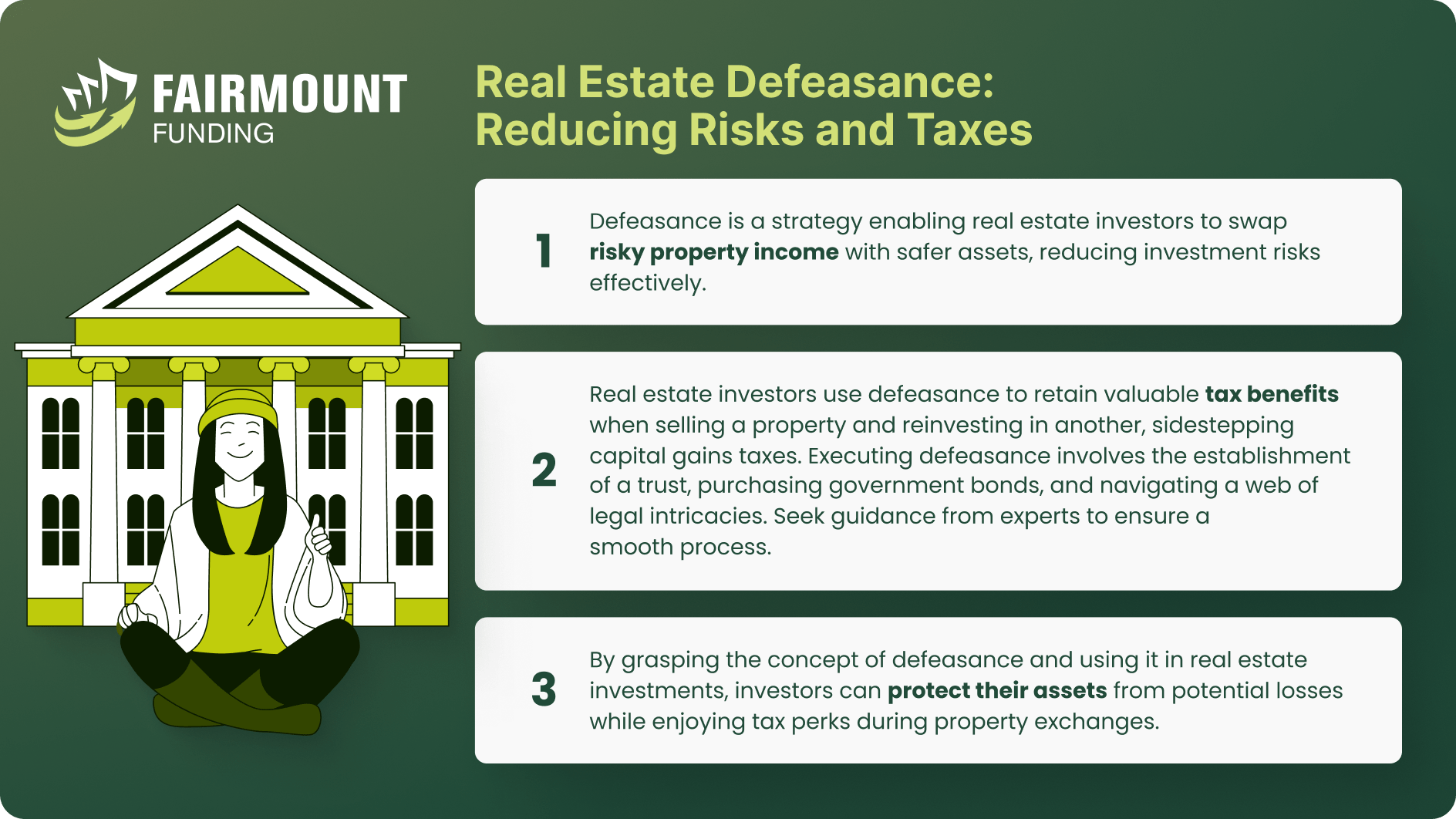
When it comes to real estate investing, there is a valuable strategy called defeasance. It’s not a word that is commonly used in everyday conversation, but it represents a financial maneuver that real estate investors can use to reduce risks and make more money in real estate.
Defeasance allows investors to get out of mortgage without facing extra fees. This can assist real estate investors in achieving full ownership of their property or in balancing their debt payments with income generated from interest-bearing securities. Let’s define defeasance and how it works.
How Defeasance Works
Defeasance involves replacing property used as collateral with bonds. A borrower offers bonds and cash to release the property, taking them off the balance sheet. This is handy when a borrower wants to sell the property.
Many bond agreements include a defeasance clause, allowing borrowers to do so under specific conditions. To use this option, borrowers must follow the clause’s rules. It specifies acceptable collateral securities and their minimum market value, and outlines when borrowers can use this method. However, not all bonds have a defeasance clause. Without it, you can’t use this process for early debt retirement. Carefully review your bond agreement to understand its prerequisites and conditions. Defeasance can be complex and time-consuming but ultimately benefits both parties.
Defeasance offers key benefits, including the avoidance of prepayment penalties, asset liquidity preservation for real estate investors, and effective risk mitigation by replacing collateral with secure, income-generating securities like government bonds. It offers an appealing alternative for borrowers seeking to break free from the confines of their initial loan agreement. It empowers them to either attain full ownership of their property, unburdened by the original loan, or balance their debt expenses against future income from interest-bearing securities.
Furthermore, defeasance proves advantageous for borrowers aiming to capitalize on lower interest rates. When investors utilize defeasance to refinance their loans, they may secure more favorable interest rates, potentially reducing monthly payments and the total interest paid throughout the loan’s lifespan. This makes defeasance an attractive strategy for borrowers in a changing interest rate environment.
Is defeasance the same as a prepayment penalty?
Defeasance and prepayment penalties both involve the management of mortgage loans, however, they work differently and serve different purposes.
1. Purpose
The primary purpose of defeasance is to replace the collateral (usually property) securing a loan with low-risk securities. This lets borrowers free the property from the lender’s lien without facing prepayment penalties, all while keeping the existing loan. In contrast, prepayment penalties are charges meant to compensate lenders for lost interest income when borrowers pay off loans early, aiming to discourage early repayment.
2. Mechanism
Defeasance involves replacing collateral with income-generating securities and continuing to service the loan. The original loan terms and interest rate typically remain intact. Prepayment penalty is a financial penalty imposed directly on the borrower for paying off the loan early. This fee is added to the final payoff amount.
3. Outcome
A change in the collateral, allowing borrowers to sell the property or make other strategic financial decisions without incurring prepayment penalties is the result of defeasance. The outcome for prepayment penalty is a financial penalty paid by the borrower for early loan payoff. It does not change the collateral or the terms of the loan.
4. Timing
When borrowers want to release a property from collateral without paying off the loan early, they use defeasance. When borrowers choose to pay off the loan before its maturity date, they get the prepayment penalty.
Choosing Between Defeasance and Yield Maintenance
Defeasance and yield maintenance are both methods used in commercial real estate financing when borrowers want to pay off their loans before their scheduled maturity dates. Choosing between defeasance and yield maintenance involves understanding the differences between these collateral replacement tactics and determining the most suitable option for your specific financial situation.
The choice is influenced by the lender’s defeasance agreement terms and specific financial factors. Generally, defeasance is the better choice when bond interest rates are compounded monthly, and payments are calculated until maturity, especially when the overall yield maintenance prepayment penalty is substantial.
Conversely, yield maintenance tends to be more advantageous when bond interest rates are compounded annually, and payments are calculated up to the loan’s prepayment date, especially when the overall yield maintenance prepayment penalty is lower. Using a yield maintenance calculator and defeasance calculator can prove to be valuable tools to determine the costs associated with yield maintenance and evaluate whether defeasance may be a more cost-effective option.
3 Steps to Perform Loan Defeasance
Paying off a loan or refinancing is pretty simple. But if you want to use defeasance, which involves buying securities to cover your loan costs, you’ll need to create a special account called a defeasance escrow account. This account holds the securities you need for defeasance. Here’s how to set it up:
STEP 1: Look for a Qualified Trustee
To facilitate defeasance, secure a qualified trustee authorized by the SEC to manage collateral securities in an escrow account. Once identified, transfer the necessary securities to this account. The trustee’s role is vital, ensuring proper security management and compliance with regulatory standards throughout the process. This collaboration provides borrowers with confidence that their collateral is in capable hands.
STEP 2: Carry Out a Trust Agreement
This agreement serves as a blueprint for the defeasance process, clarifying the roles and responsibilities of all involved parties to ensure a smooth operation. Once the defeasance escrow account is established and the trust agreement is formally executed, the collateral securities are securely held in the account. These securities remain safeguarded until the moment they are needed to retire the old bond, providing a structured and reliable approach to managing the defeasance process.
STEP 3: Defease Your Bond
When it’s time to complete the loan defeasance process, the trustee utilizes the collateral securities to cover the necessary interest and principal payments on the old bond. Once these payments are settled, the defeased bond is officially retired, and the borrower’s obligations under the original loan agreement are discharged.
Defeasance FAQs
When is it a good idea to use defeasance?
Defeasance is a good idea to use when you want to release a property from a mortgage without incurring prepayment penalties or when you wish to change the collateral for your loan.
Can defeasance help refinance my real estate loans?
Yes, defeasance can help facilitate the refinancing of real estate loans by allowing borrowers to release properties from existing mortgages without incurring prepayment penalties. This flexibility is helpful if you’re seeking lower interest rates or planning to sell your property.
What are the risks of using defeasance?
The primary risks of defeasance in commercial real estate stem from its complexity and associated costs. It often requires a team of experts, takes time, and involves a substantial capital investment in replacement collateral, typically bonds.
For borrowers, the risks depend on their specific situation and economic conditions. Defeasance may be disadvantageous if interest rates are expected to rise, especially for variable-rate loans, as it may prevent borrowers from taking advantage of lower rates.
Start Your Path to Substantial Loan Savings
The primary objective of defeasance is to provide borrowers with the opportunity to secure a lower interest rate for the remaining duration of their loan. This strategic financial move is motivated by the potential for substantial cost savings throughout the life of the loan.
By locking in a lower interest rate through defeasance, borrowers effectively reduce the amount of interest they will pay over the course of the loan. This translates into more affordable monthly payments and an overall reduction in the total interest expense, which can amount to significant savings. In essence, defeasance empowers borrowers to optimize their financial situation by taking advantage of favorable interest rates, leading to a more cost-effective and financially advantageous loan repayment journey.
KEY TAKEAWAYS
- Defeasance is when a borrower switches out the property used for a mortgage with enough money and bonds.
- Defeasance lets you get rid of certain future cash payments you owe on a bond.
- Defeasance aims to enable borrowers to secure a lower interest rate for the remaining duration of their loan.


